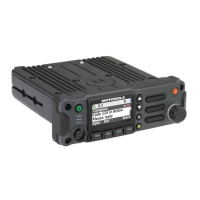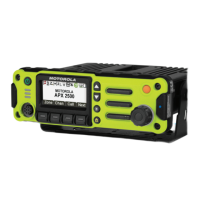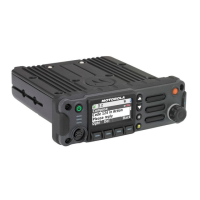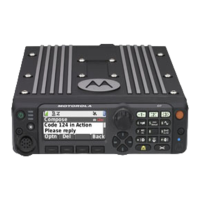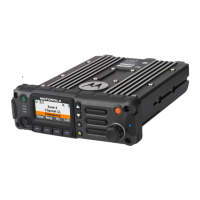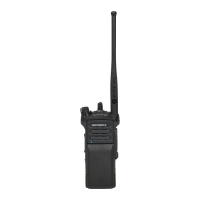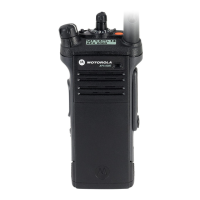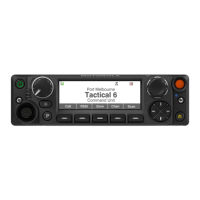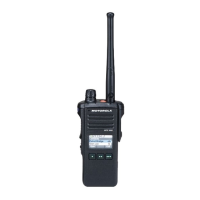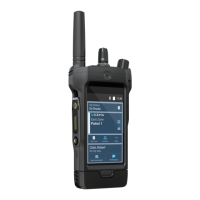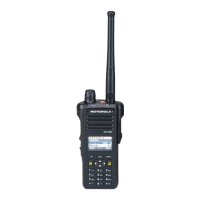Basic Theory of Operation: Analog Mode of Operation 3-5
3.2.1.2 VHF Front-End
From the 15 dB Step Attenuator, a VHF signal is routed to the first pre-selector filter followed by an
LNA and a second pre-selector filter. Both filters are discrete and tunable designs and are used to
band limit the incoming energy and suppress known spurious responses such as Image and the ½ IF
spur. The output of the second pre-selector filter is applied to the RF port of the Mixer IC. The Mixer
IC is also excited by a Local Oscillator (LO) signal at the LO port to down-convert the RF signal to a
109.65 MHz intermediate frequency (IF). The down converted IF signal is passed through a crystal
filter which drives the input of the Abacus 3 Analog to Digital Converter IC (AD9864).
3.2.1.3 UHF1/UHF2 Front-End
From the 15 dB Step Attenuator, a UHF1/UHF2 signal is routed to the first pre-selector filter followed
by an LNA and a second pre-selector filter. Both filters are discrete and tunable designs and are
used to band limit the incoming energy and suppress known spurious responses such as Image and
the ½ IF spur. The output of the second pre-selector filter is applied to the RF port of the Mixer IC.
The Mixer IC is also excited by a Local Oscillator (LO) signal at the LO port to down-convert the RF
signal to a 109.65 MHz intermediate frequency (IF). The down converted IF signal is passed through
a crystal filter which drives the input of the Abacus 3 Analog to Digital Converter IC (AD9864).
3.2.1.4 700/800 MHz Front-End
From the 15 dB Step Attenuator, a 700/800 MHz band signal is routed to the first band SPST switch
which selects the 700 or the 800 band signal and routes it to the appropriate first pre-selector filter. A
second band select switch selects the output of the appropriate filter and applies it to an LNA
followed by a similar pre-selector filter/ band-select switch circuit. The signal is then routed to a
second LNA whose output is applied to a discrete image filter. Both preselector filters are Surface
Acoustic Wave designs used to band limit the received energy and suppress known spurious
responses such as Image and the ½ IF spur. The output of the discrete image filter is applied to the
RF port of the Mixer IC. The Mixer IC is also excited by a Local Oscillator (LO) signal at the LO port
to down-convert the RF signal to a 109.65 MHz intermediate frequency (IF). The down converted IF
signal is passed through a crystal filter which drives the input of the Abacus 3 Analog to Digital
Converter IC (AD9864).
3.2.1.5 900 MHz Front-End
From the 15 dB Step Attenuator, the 900 MHz band signal is routed to the pre-selector filter. The
output of the prefilter is applied to the first LNA followed by a similar filter as the pre-selector filter.
The signal is then routed to a second LNA whose output is applied to a discrete image filter. Both pre
and post selector filters are Surface Acoustic Wave designs used to band limit the received energy
and suppress known spurious responses such as Image and the ½ IF spur. The output of the
discrete image filter is applied to the RF port of the Mixer IC. The Mixer IC is also excited by a Local
Oscillator (LO) signal at the LO port to down-convert the RF signal to a 109.65 MHz intermediate
frequency (IF). The down converted IF signal is passed through a crystal filter which drives the input
of the Abacus 3 Analog to Digital Converter IC (AD9864).
3.2.1.6 Analog To Digital Converter
The ADC IC's front end down converts the first IF to a second IF, a 2.25 MHz signal. The second IF
is sampled at 18 MHz, a signal generated by an integrated clock synthesizer. The sampled signal is
decimated by a factor of 900 to 20 kHz and converted to SSI format at the ADC's output. The Serial
Synchronous Interface (SSI) serial data waveform is composed of a 16 bit in-phase word (I) followed
by a 16 bit Quadrature word (Q). A 20 kHz Frame Synch and a 1.2 MHz clock waveform are used to
synchronize the SSI IQ data transfer to the Digital Signal Processor IC (OMAP) for post-processing
and demodulation.
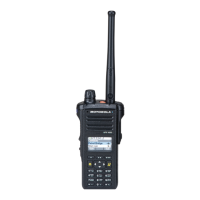
